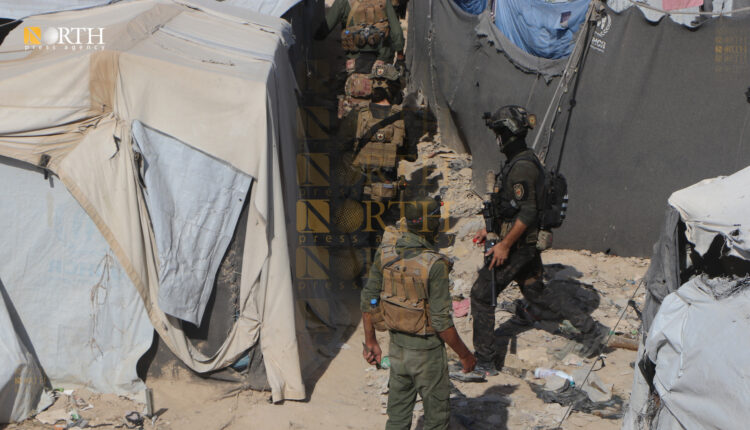
By Lamar Erkndi
QAMISHLI, Syria (North Press) – The Islamic State (ISIS) is exploiting Syria’s ongoing instability to expand its operational reach, particularly in the wake of the Assad regime’s collapse and the withdrawal of Syrian forces from key areas. Recent intelligence warns of imminent ISIS operations, including attacks in Europe and coordinated strikes against detention centers in Syria and Iraq.
“ISIS threats”: Exploiting Syria’s Instability
Since the fall of the Assad regime, the withdrawal of Syrian forces and Iranian militias has left regions in central and eastern Syria exposed. ISIS has taken advantage of this vacuum, increasing its activity in these territories, which it now considers among its most significant strongholds.
Exclusive information obtained by North Press indicates that ISIS is planning to leverage the global distraction of New Year celebrations to launch attacks in Europe. In addition, there are credible threats of prison breaks targeting facilities holding ISIS members, including the SDF-managed prisons in Hasakah (such as Sina’a and al-Shaddadi prisons) and the Derik prison near Qamishli. Similarly, in Iraq, ISIS is reportedly eyeing high-profile detention centers like al-Rasafa in Baghdad and Nasiriyah Central Prison.
Iraq Takes Precautionary Measures
An Iraqi security official, speaking to North Press on condition of anonymity, confirmed that Baghdad has tightened security around its detention facilities. “We have specific intelligence about ISIS’s plans to target prisons in both Iraq and SDF-controlled regions. New strategies have been implemented to ensure these facilities are well-protected,” the official explained.
He further highlighted the importance of cross-border cooperation between Iraq and Syria in countering ISIS’s movements. “Securing our borders has been a priority since the initial days of the regime’s collapse in Syria, preventing infiltration of ISIS operatives between the two countries.”
The Rise of “Lone Lions”
ISIS has shifted its focus to mobilizing “lone lions,” urging them to carry out attacks in Europe, the United States, and Israel. Audio messages and social media posts from ISIS leaders call for action during New Year celebrations. “Prepare your belts, silencers, knives, and explosives,” one message exhorts, targeting “Crusaders and Jews” across the globe, including within Israel and the Palestinian territories.
The call to action also extends to efforts to liberate detained ISIS members, with specific instructions for attackers to focus on detention facilities in Iraq and Syria.
Iran’s Complicated Role
Iraq’s Foreign Minister Fuad Hussein issued a stark warning about the dangers of ISIS exploiting security lapses in Syrian prisons and camps like al-Hol. The minister highlighted how ISIS has reorganized, acquiring significant weapon stockpiles left behind by retreating Syrian forces.
Former Syrian army officers speaking to North Press corroborated these claims, adding that Iran’s Revolutionary Guard Corps (IRGC) has covertly integrated ISIS operatives into its ranks in Deir ez-Zor, al-Mayadin, and al-Bukamal. According to retired Colonel Fathi Hassan, these operatives facilitated secret operations with Iranian leadership while maintaining their allegiance to ISIS.
In a notable incident last year, several ISIS members were reportedly disguised as IRGC personnel and transported to Damascus. A subsequent bombing in the Sayyida Zainab district—a Shiite pilgrimage site—killed 20 people and was claimed by ISIS. Sources suggest that this attack was part of a covert arrangement with Iranian officials, raising questions about how ISIS operatives infiltrated a heavily secured area in the Syrian capital.
ISIS’s Arms Cache and Drones
The collapse of the Syrian army and the withdrawal of Iranian militias left significant weapon caches in ISIS’s hands. According to Ayham, a former officer in the Syrian army, ISIS operatives with ties to the IRGC transported these weapons—including drones, rockets, and launchers—to the Syrian desert. “These supplies are enough to sustain ISIS operations for at least five years,” he stated.
The collaboration between ISIS and Iran extends beyond weapon transfers. Iranian leaders have reportedly used ISIS-controlled areas in the Syrian desert to shelter IRGC commanders targeted by Israeli airstrikes. These arrangements have provided ISIS with both resources and strategic depth, allowing the group to expand its influence.
Rising Terrorist Activity
The Syrian Observatory for Human Rights reported that ISIS conducted nearly 500 operations across Syria in 2024, resulting in over 750 deaths, including civilians and military personnel. The Syrian Democratic Forces (SDF), supported by the U.S.-led coalition, launched counter-operations that killed 117 ISIS fighters and leaders.
Experts warn that ISIS’s activities have intensified globally. According to the 2024 Global Terrorism Index, terrorism-related incidents increased by 22% compared to the previous year. The resurgence of ISIS reflects the broader consequences of the ongoing chaos in Syria and Iraq, underscoring the urgent need for coordinated international action.
A Growing Global Threat
ISIS’s exploitation of security gaps in Syria and Iraq, combined with its decentralized strategy of mobilizing “Lone Lions,” poses a significant threat to global stability. The group’s ability to regroup, acquire weapons, and plan operations in conflict zones highlights the enduring dangers of unresolved regional crises.
As the world celebrates a new year, the international community must strengthen its counter-terrorism efforts. Enhanced intelligence-sharing, cross-border cooperation, and a focus on long-term solutions to the root causes of extremism are essential to countering the evolving ISIS threat.
